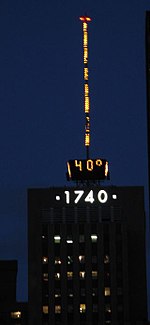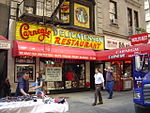Park Central Hotel
1927 establishments in New York CityHotel buildings completed in 1927Hotels established in 1927Hotels in ManhattanMidtown Manhattan ... and 5 more
Renaissance Revival architecture in New York CitySeventh Avenue (Manhattan)Sheraton hotelsSkyscraper hotels in ManhattanUse mdy dates from November 2020

The Park Central Hotel is a 25-story, 935-room hotel located across the street from Carnegie Hall at 870 7th Avenue (between West 55th and 56th Streets) in Midtown Manhattan, New York City. It was designed in the Renaissance Revival style and opened on June 12, 1927. The Park Central is an independent hotel managed by Highgate Holdings.
Excerpt from the Wikipedia article Park Central Hotel (License: CC BY-SA 3.0, Authors, Images).Park Central Hotel
7th Avenue, New York Manhattan
Geographical coordinates (GPS) Address External links Nearby Places Show on map
Geographical coordinates (GPS)
| Latitude | Longitude |
|---|---|
| N 40.764722222222 ° | E -73.981111111111 ° |
Address
Park Central Hotel
7th Avenue 860
10019 New York, Manhattan
New York, United States
Open on Google Maps






